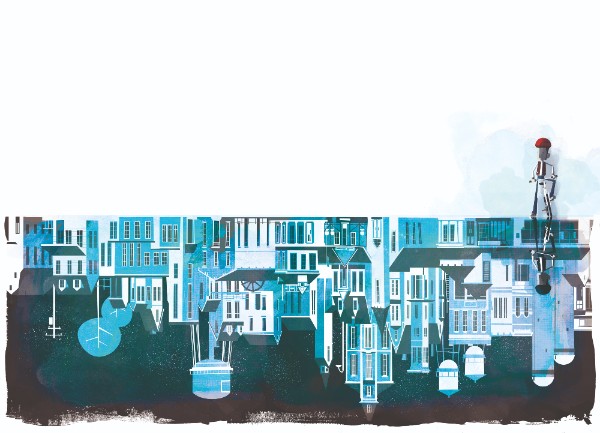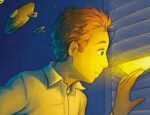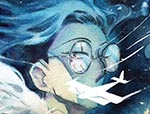
Our Inside Look feature at Broken Frontier provides creators with the opportunity to share exclusive commentaries on their comics projects with our readers, giving insights into the genesis, process and themes of their work. It’s one of the oldest regular features at BF, first appearing on the site back in the mid-2000s and also one of our most well-received. Today’s edition comes from 2021 Broken Frontier ‘Six to Watch‘ creator Norm Konyu whose critically acclaimed debut graphic novel The Junction we originally reviewed in its self-published edition form here at Broken Frontier. We also interviewed Norm about his work last year at BF. To mark Titan picking up the book and publishing it in April, Norm has contributed this exclusive behind-the-scenes look at the evolution of the project.
From the Titan press release:
When a missing child, Lucas Jones, reappears on his Uncle’s doorstep in his hometown of Medford after an absence of 12 years, the brief moment of joy is clouded by mystery. Where has he been? Where is his father who disappeared at the same time? And how is it possible that Lucas is still 11 years old?
As Lucas is uncommunicative, it is left to Detective Sergeant David King and child psychologist Jean Symonds to attempt to find some answers from the few belongings Lucas returned with; little more than four Polaroids and a personal journal which speaks of his time in a place called ‘The Junction’.
The story unravels through interviews, medical and police reports, and, ultimately, through visits to The Junction via the pages of Lucas’s diary, jumping back and forth in time, revealing pieces of the puzzle in a mystery that keeps the reader guessing right up until the end.
Over to Norm…
In mid-April, my debut graphic novel, The Junction, originally a Kickstarter project, was released by Titan Comics. I assure you I was as surprised as anyone when Titan approached me last year. For one, the book started simply as an exercise to find my own personal style. Secondly, I had no idea what I was doing during the creation process. And lastly, I never thought I’d ever get it completed in the first place, especially considering the string of newbie errors I made along the way.
I’m an animator by trade, and I’ve worked with a lot of popular animated characters over the years for places such as Cartoon Network and Nickelodeon, often drafted in to do publicity animation for them. Great work to have, but as an animator, you’re usually working on somebody else’s characters in somebody else’s style, and there came a point I realised that I no longer knew what my own style was anymore. And I suppose that was the initial spark for The Junction, the barest skeleton of a story I had floating around in the back of my mind.
I wanted to do something that was 100% Norm Konyu, whatever that meant, and after animating all day, the last thing I wanted to do was more animation in the evening. So a comic book was the most appealing option. I say ‘comic book’ as I thought The Junction was going to be a much shorter book, nothing like the 176 pages of artwork it eventually became. I really had no concept of how many pages it would take to tell the story. My mind was too used to telling a story as a factor of time, not panel numbers. That was error no. 1. Let’s keep a count on that error count as we go along, shall we?
I correctly assumed it would take a while to find that personal style. A couple of weeks I thought. Hah! Error no.2. Six or eight months was the reality of it. Even then, during the actual creation, there were tweaks along the way.
The story process went strangely smoothly. I started with the conclusion and worked my way backwards from there. I do a fair amount of stuff backwards. For example, my Mother tells me I never learned to crawl forwards as a baby. I crawled backwards, then I learned to walk. People who know me probably won’t be surprised by this. After I had the story chronologically developed, I mixed up the order in an effort to retain the mystery as long as possible, and there it was, the story mapped out. Painlessly. Maybe I was finished with errors. Maybe it was all going to be plain sailing from then on. Dream on, Norm.
Thumbnailing and planning. I should just call this section Error no. 3. Maybe Errors 3 – 8 if I’m really being honest as this was my worst moment. I simply didn’t plan enough. I was way too eager to just dive into the artwork. After all, it had taken me so long to find the style, I just wanted to apply it. I did some thumbnails. But I really didn’t really think that hard about them, about the flow, how they moved the story along. The result? Wasted time. Lots of it. Digital art in the digital wastebasket. Lots of cursing. A sidelining of the entire project for a time.
I did eventually return to the book (obviously), but this time with a much more considered approach to the planning, but shortly after that I moved into Error no.4 – how I approached the artwork. For some unfathomable reason, I approached each frame as a separate piece, not each page as a cohesive piece of art. This added ridiculous amounts of time in the layout process, sewing all those disparate frames into pages, balancing the colours, resizing as needed. Messy. Unnecessary.
Now, surely I must have been close to finishing. No. I managed to screw up the lettering. Error no. 5. I chose one font for dialogue, another for descriptions, and yet another for text from written sources. It was like those old websites built with Flash in the Noughties, where the designer said “I can have this moving, and this bit over here changing colour, and this section scrolling, while an animated cat dances in the upper right corner of the screen”, leading to an absolute visual riot that instantly induced headaches in the viewer. That was my lettered page. Luckily, a friend (Hey Hannah!) pointed out the folly of my ways on the pages I showed her, saying it made her brain fizz, though she may not have worded it quite so politely. Once highlighted, it was obvious. I went back and chose a single font and stuck with it.
I put the book aside at this point, sure I was now finished. Error no.6. When I returned to it, it was with fresh eyes, and like the error of my lettering choices, problems became immediately apparent; clunky dialogue, panels that didn’t flow as smoothly as they should, artwork improvements, and especially a need to keep the jumps in time separated clearly to help the reader navigate them.
Eventually, I accepted it was done.
And then I Kickstarted The Junction in March 2020, just as the world as we knew it, turned upside down and went into lockdown. And that, folks, was Error no. 7.
“a beautiful, haunting and utterly unique graphic novel. Smartly written and drawn. Loved it. Recommended!” – Mike Collins (Doctor Who, Good Omens, The Witcher, His Dark Materials)
“… Norm Konyu’s THE JUNCTION is probably my favourite graphic novel. Gorgeous in every way, it is hallucinatory, moving, and always mesmerizing. “ – Jordan Roberts (Writer of Big Hero 6, March of the Penguins)
The Junction is available to order from most book and comic outlets, so you can enjoy its error-free mystery (after all, I must have gotten all the errors out of the way now….)




















